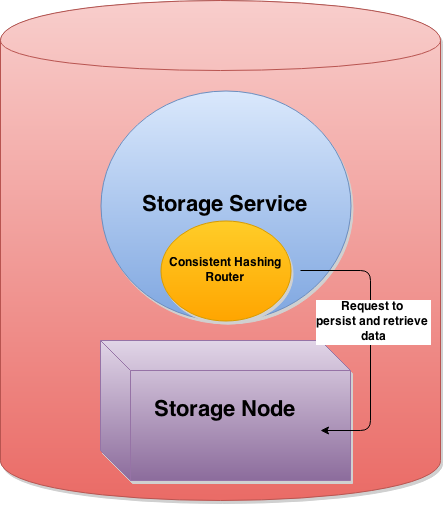Dynamo like distributed database built using Akka Cluster
AkkaDynoDB is a reactive storage service inspired from the Amazon dynamo distributed database which is Highly available, scalable and resilient database All Things distributed Paper. With changing requirements of enterprise applications the way we build applications has been changing. With increasing number of devices that connect to the internet the traffic per server has drastically changed over years and its going to increase much more in the near future with the emergence of Internet of things(IOT). In order to cater to the changing requirements which cannot be handled by traditional architectures many enterprises started adopting distributed architectures to spread load over large number of machines and handle user requests. These applications should also handle data effectively and offer reliability to its users. As the number of users increasing the applications must also scalable well according to the need. Not only scalability and reliability users also expect 100% availability that means 0 down times even in case of database maintenance and data migration. In order to offer these essential features enterprises have been adopting certain best practices and techniques from different researches. Reactive design principles basically convey these best practices and how systems should be built from ground up to be scalable, available and be resilient.
Reactive Systems has these four traits
-
Responsive (Available in a responding state)
-
Resilient (Fault tolerant)
-
Elastic (Scalable)
-
Message Driven (Communicate by sending messages i.e core to distribution)
Please read Reactive Manifesto to know about what is to be reactive.
Akka as mentioned here akka.io is a toolkit and runtime for building
-
Highly Concurrent
-
Distributed
-
Resilient
-
Message-Driven applications on JVM (Java Virtual Machine)
Akka adheres to the reactive principles and offers abstractions to deal with concurrency, distribution and fault tolerance.
-
For concurrency Akka offers Scala Futures and Agents. (Helps Scale up)
-
For Distribution and Remoting it offers Actors. (Helps Scale Out)
-
For Fault tolerance Actor Supervision. (Deal with Failure)
Note: The above mentioned is not exhaustive list of what akka offers. Please visit Akka Website for more.
More about actors Actor Model, Actor Model.
Actor Model of concurrent computation provides a primitive called as Actor.
Actor is an entity which can do these three things
-
Communicate with message passing (can communicate)
-
Create new actors (Can create new actors)
-
decide what to do with next message (Can change its behaviour on receiving a message)
Actors can also have mutable state and can take local decisions. Actors can be used for distributing work among different machines. With the help of actors work can be distributed among other worker actors and performed in a concurrent and distributed manner. Actors provide location transparency by which same semantics of communication that are used for local actors can be used with remote actors. Running potential long running code inside the actor makes the actor deaf to the messages that are sent to it. So, it is recommend to wrap long running code inside a Future and execute it.Akka provides handy syntax to do the same.
object MasterActor {
case object StartWork
}
class MasterActor extends Actor with ActorLogging {
def receive = {
case StartWork => {
val future = Future {
longRunningCode
}
future pipeTo self //pipe feature
}
case _ => log.info("unknown message")
}
def longRunningCode: Unit = Thread.sleep(1000000)
}
Akka Cluster
Akka Cluster provides a fault tolerant decentralized peer-to-peer based cluster membership service with no single point of failure or single point of bottleneck. It does this using gossip protocols and a automatic failure detector Akka Cluster Specification Intro
Please have a look at Akka Cluster documentation here Akka Cluster
To do
Overall AkkaDynoDB looks like this
Each Node in the cluster sends heart beats to every other node in the cluster to know whether a particluar node is dead or alive.AkkaDynoDb uses Akka Cluster so, all that applies to Akka Cluster also applies to AkkaDynoDB
Interactions of single Node of Cluster
The above picture depicts the interactions of the single node with other nodes. All nodes are in consistent hashing ring
Node in detail
Each node in the cluster consists of these three components
- Service Actor
- ConsistentHashing Router in the Service Actor
- Storage Actor which persists the data into store
Service Actor receives all the client requests to persist and retrieve the data. Then the request is sent to the Consistent Hashing router. The request consists of the Key which helps the Router to dispatch the request to the final node in which the data is stored. If the key belongs to the Node itself then the request is sent to the Storage Actor itself and will not be routed.
This is inside the Service Actor . The responsibility of the router is to take the request and dispatch it to the corresponding node which is responsible for handling the data. This is done by using the key in the request. Also Consistent Hashing Router helps in both read and write request scalability there by preventing hot stops in the system.
Storage Actor is responsible for persisting the data and retrieving the data that is requested by the Service Actor and this request is dispatched by the consistent hashing router in the service node.
Routers in Akka helps in balancing/distribution the load on the system by dispatching the request to different worker actors based on some criteria.There are two kinds of routers
- Pool Router (creates workers by itself)
- Group Router (Give created workers to the router, Group router does not create any worker actors by itself)
Consistent Hashing Router routes messages to workers based on Consistent Hashing Algorithm




